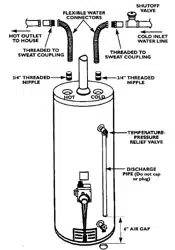Loading ...
Loading ...
Loading ...

Troubleshooting Guide (cont'd)
Leakage Checkpoints
Use this gu!de to check a "Leaking" water heater. Man)" suspect-
ed "Leakers are not leaking tanks. Often the source of the water
can be found and corrected.
If you are not thoroughly familiar with your local gas codes your
water heater, and safety practices, contact the _ Service
_enter to check the water heater.
_- . A CAUTION 1
IRead this manual first. Then before checking the water I
lheater make sure the gas supply has been turned|
I "OFF", and never turn the gas "ON" before the tank isJ
I completely full of water, J
l • ACAUTION 1
Never use this water heater unless it is completely filled J
with water. To prevent damage to the tank, the tankJ
must be filled with water, Water must flow from the hot|
water faucet before turning "ON" gas to the waterJ
heater,
I
O Water at the draft hood is water which has
vapor
condensed out of the combustion products. This is caused
by a problem in the vent. Contact the Sears Service
Center.
O *Condensation be seen on pipes in humid weather or
may
pipe connections may be leaking.
O'The primary anode rod fitting may be leaking.
Small amounts of water from the temperature-pressure
relief valve may be due to thermal expansion or high
water pressure in your area.
O'The temperature-pressure may leaking at
relief valve be
the tank fitting.
O
®
O
O
Water from a drain valve may be due to the valve opened
slighdy.
*The drain valve maybe leaking at the tank fitting.
Combustion products contain water vapor which can
condense on the cooler surfaces of the tank. Droplets
form and drip into the fire or run on the floor. This is
common atthe time ofstartup afterinstallation and when
incoming water is cold.
Water in the water heater bottom or on the floor may be
from condensation, loose connections, or the relief valve.
DO NOT replace the water heater until a full inspection
of all possible water sources is made and necessary
corrective steps taken. Leakage from other appliances,
water lines, or ground seepage should also be checked.
NOTE: To check where threaded portion enters tank,
insert cotton swab between jacket opening and fitting.
If cotton is wet, follow "Draining" instructions in the
"Service and Adjustment" section and then remove
fitting. Put pipe dope or teflon tape on the threads
and replace. Then follow "Filling the Water Heater"
instructions in the Installation Instructions section.
25
Loading ...
Loading ...
Loading ...
